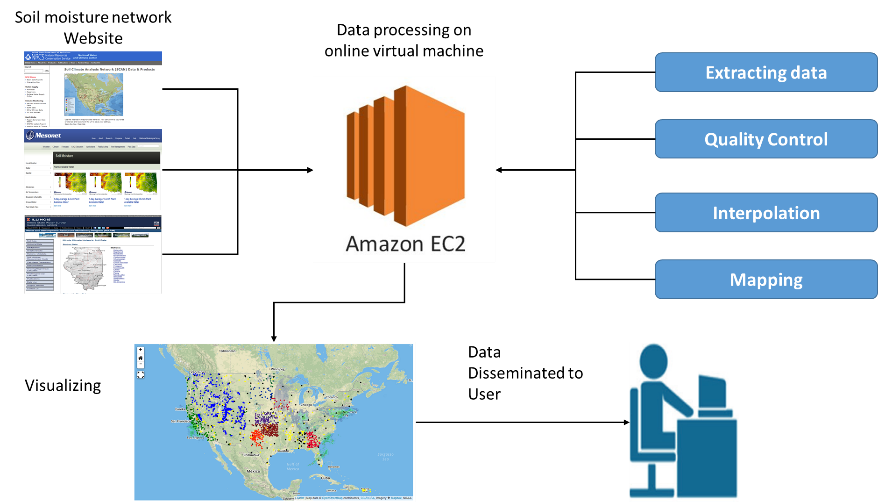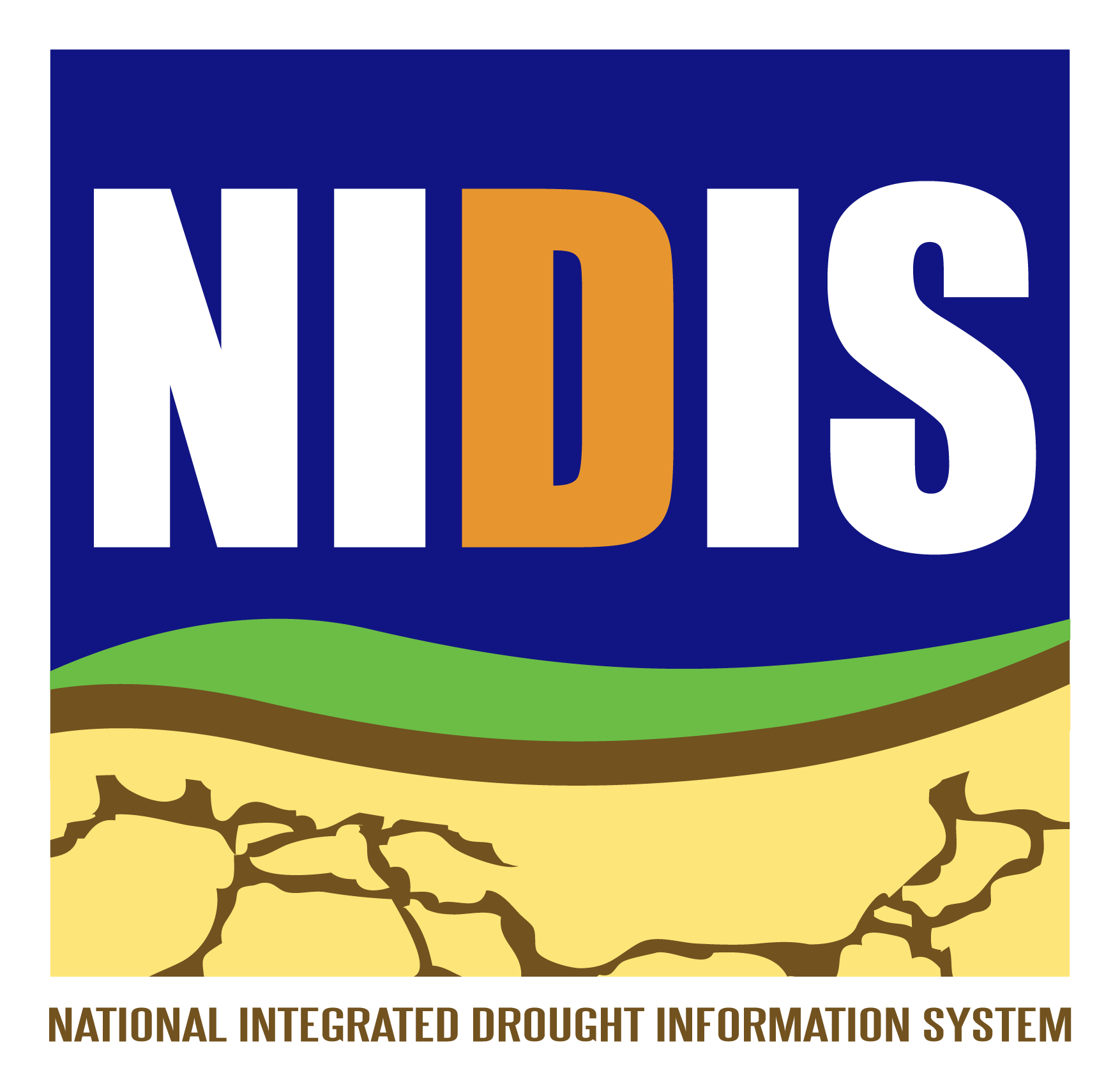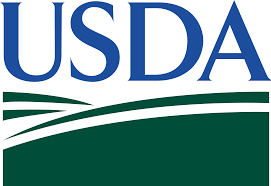Objective
This site supports operational monitoring of soil moisture conditions in the contiguous United States. It utilizes in situ measurements of soil moisture as well as model-derived and satellite-derived soil moisture to develop high-resolution (4 km) gridded soil moisture products for the contiguous United States.
Soil moisture maps are provided for the 5 cm, 20 cm and 50 cm depths. They are updated every day based on current soil moisture conditions. Soil water content is reported as a percentile (0 to 100) and the maps are color-coded based on the United States Drought Monitor categories (D0 to D4). The percentiles are calculated based on the historical record and they compare the soil water content to the historical distribution of soil water content at that location and in that month (details on the calculation of soil moisture percentiles are available here).
This site provides soil moisture data from in situ measurements, NASA SMAP (L3) and NLDAS-2 Noah model. More details on each of these datasets are provided below.
Products
Near real-time in situ interpolated soil moisture percentiles
The in situ soil moisture measurements are collected each day at ~7 am (local time) from >2,200 locations. These stations are part of a variety of local, state and federal networks. This site would not exist without the essential data collection that is undertaken by our collaborators. Data are retrieved with a 1-day latency. The locations of the stations that provide soil moisture data are shown as circles on the maps. The number of available stations varies each day based on what is available from the data providers.
The soil water content measurements (volumetric water content) are converted to percentiles based on the empirical cumulative distribution function (CDF) for each station. The CDF is computed using the entire period of record. A 30 day moving window, centered on the target date, is applied to generate an empirical CDF.
Inverse Distance Weighting (IDW), Ordinary Kriging (OK) and Regression Kriging (RK), three different interpolation methods, have been used to interpolate soil moisture percentile data into 4 km grids. Our analysis shows that the RK product is the most accurate. More details on the interpolation methods that are used to produce the daily soil moisture maps are available here.
Near real-time NLDAS-2 Noah soil moisture percentiles
Each day the 0600 hourly NLDAS-2 Noah model output is downloaded from the NASA GES DISC portal. Due to the latency of the 2 model output, data have a ~5 day latency. The NetCDF file is used to first replace any masked values with no data. Next, the liquid soil moisture content (non-frozen) and total soil moisture content variables are retrieved from the NetCDF. If a frozen soil filter is applied, soil moisture for the whole column is removed if the total and liquid soil moisture are not equal in any layer. The native units of NLDAS soil moisture (kg/m2) are then converted to volumetric water content (VWC) by dividing the moisture content by the soil layer thickness (mm). VWC anomalies are then generated by subtracting the mean daily value (1998-2017) from the daily VWC. Next, VWC percentiles are calculated according to each location's empirical CDF. The CDF is computed from the 1998-2017 VWC anomaly time series and a two-sided five day moving window is applied to generate an empirical CDF (n=100). Finally, the NLDAS VWC percentile data are clipped to the US and rescaled to the PRISM (4 km) grid using a cubic spline one dimensional interpolation.
Near Real-Time SMAP Soil Moisture Percentiles
Each day, the NSIDC subscription service provides a link to the most recently processed SMAP L3 enhanced data. This latency can vary, but is limited to 50 hours. To match the NLDAS time step, SMAP data is processed at a five day latency. The latitude, longitude, soil moisture (SM), SM_Error, and Flags variables are extracted from the hdf5 file. It should be noted that the SMAP data is originally stored on NASA's EASE grid. SMAP quality control flags are then applied to the data and only SM data of recommended quality are stored. Next, soil moisture retrievals from the AM and PM passes are merged using an averaging approach if there are overlapping retrievals. VWC is then converted to anomalies by subtracting the mean daily value (March 31, 2015-September 1, 2018) from the daily VWC. Next, VWC percentiles are calculated according to each location's empirical CDF. The CDF is computed from the March 31, 2015-September 1, 2018 VWC anomaly time series and a two-sided 30 day moving window is applied to generate an empirical CDF (n is variable). Finally, the SMAP VWC percentile data are clipped to the US and rescaled to the PRISM (4 km) grid using centroid matching. SMAP soil moisture data are also provided as a 3-day average to provide better coverage of satellite measurements.
Near Real-Time Blended Products
To match the NLDAS time step, the simple blend product is generated at a five day latency. The simple blend is computed using a simple average to combine the NLDAS Noah 0-10 cm VWC percentiles, the SMAP L3 enhanced VWC percentiles (~5 cm), and the 5 cm regression kriging (RK) in situ VWC percentiles. Blends of NLDAS and regression kriging soil moisture are also produced for the depths of 5, 20, and 50 cm. The uncertainty of the blended products is expressed as the relative difference between soil moisture measurements from different products.
Contributing Networks
Background
Soil moisture is also influenced by other factors. For example, routing processes that are affected by topography influence near-surface soil moisture. Numerous studies have demonstrated that soil moisture is generally lower at locations that are further upslope (Champagne et al., 2010; de Rosnay et al., 2009; Mohanty et al., 2000b). Land cover also plays an important role in determining soil moisture through modifying infiltration and evapotranspiration. Mohanty et al. (2000a) found that vegetation dynamics had a significant impact on intra-seasonal spatial patterns of soil moisture, which is consistent with other studies (Jacobs et al., 2004; Vinnikov et al., 1996). Isham et al. (2005) used a stochastic rainfall model and to demonstrate that the spatial variability of soil moisture is not only controlled by the spatial variability of vegetation, but also by rainfall. Precipitation is the dominant meteorological control of soil moisture (Seneviratne et al., 2010). The impact that all of these factors have on soil moisture varies depending on the spatial scale. Therefore, accurately interpolating soil moisture based on in situ (i.e., point) measurements is challenging and requires consideration of many different factors.
Methods

Cooperators, Partners, and Subject Matter Experts
USGS-CIDA Center for Integrated Data AnalyticsUSDA-NRCS National Soil Survey Center
USDA-NRCS National Water and Climate Center
The National Integrated Drought Information System (NIDIS)
USDA Southern Plains Climate Hub
U.S. Climate Reference Network






Questions and Comments? quiring.10@osu.edu